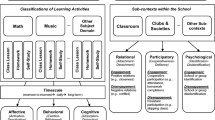Abstract
As the design thinking approach becomes more established in the instructional design (ID) discourse, the field will have to reconsider the professional identity of instructional designers. Rather than passively following models or processes, a professional identity rooted in design thinking calls for instructional designers to be dynamic agents of change who use reflective thinking to navigate the design space and develop solutions to ill-structured problems. Graduate programs in ID will also need to prepare students to manage the complexities they will encounter in their professional practice, including the establishment of design precedents, reflective thinking skills, and the foundations of professional identity. This research explored the use of reflective writing assignments in an introductory ID graduate course, with results indicating that most students are able to engage in meaningful reflection in relation to prompts concerning design concepts, experiences, and identity attributes, although no clear patterns of improvement emerged over time. Future directions for research include the use of feedback and the structure of prompts (including frequency of writing assignments and wording of prompts) to support improved student performance.





Similar content being viewed by others
References
Ada, W. W. (2010). Computer supported collaborative learning and critical reflection: a case study of fashion consumerism. Interdisciplinary Journal of E-Learning and Learning Objects, 6, 87–102.
Atkins, S., & Murphy, K. (1993). Reflection: A review of the literature. Journal of Advanced Nursing, 18, 1188–1192.
Blaschke, L. M., & Brindley, J. (2011). Establishing a foundation for reflective practice: A case study of learning journal use. European Journal of Open, Distance, and E-Learning (EURODL), Special Issue. Retrieved from http://www.eurodl.org/materials/special/2011/Blaschke_Brindley.pdf.
Boling, E. (2008). Design is not systematic: Alternative perspectives on design: Designer as human instrument. Panel session presented at the meeting of the Association for Educational Communications and Technology. Orlando, FL.
Bourner, T. (2003). Assessing reflective learning. Education + Training, 45, 267–272.
Cross, D. (2011). Design thinking. New York, NY: Berg.
Davis, E. A. (2006). Characterizing productive reflection among preservice elementary teachers: Seeing what matters. Teaching and Teacher Education, 22, 281–301. doi:10.1016/j.tate.2005.11.005.
Dewey, J. (1991). How we think: A restatement of the relation of reflective thinking to the educative process. Buffalo, NY: Prometheus Books.
Hall, H., & Davison, B. (2007). Social software as support in hybrid learning environments: the value of the blog as a tool for reflective learning and peer support. Library and Information Science Research, 29, 163–187. doi:10.1016/j.lisr.2007.04.007.
Henderson, K., Napan, K., & Monteiro, S. (2004). Encouraging reflective learning: An online challenge. In Beyond the comfort zone: Proceedings of the 21st ASCILITE Conference (pp. 357–364).
Hong, Y., & Choi, I. (2011). Three dimensions of reflective thinking in solving design problems: A conceptual model. Educational Technology Research and Development, 59, 687–710. doi:10.1007/s11423-011-9202-9.
Langley, M., & Brown, S. (2010). Perceptions of the use of reflective journals in online graduate nursing education. Nursing Education Perspectives, 31(1), 12–17.
Lawson, B. (2006). How designers think: The design process demystified (4th ed.). Oxford, UK: Elsevier.
Lawson, B., & Dorst, K. (2009). Design expertise. Oxford, UK: Elsevier.
Lin, X., Hmelo, C., Kinzer, C. K., & Secules, T. J. (1999). Designing technology to support reflection. Educational Technology, Research and Development, 47, 43–62.
Lowgren, J., & Stolterman, E. (2004). Thoughtful interaction design: A design perspective on information technology. Boston, MA: MIT Press.
Luehmann, A. L. (2007). Identity development as a lens to science teacher preparation. Science Education, 91, 822–839. doi:10.1002/sce20209.
Luppicini, R. (2003). Reflective Action Instructional Design (RAID): A designer’s aid. International Journal of Technology and Design Education, 13, 75–82. doi:10.1023/B:ITDE.0000039569.05754.a8.
Maor, D. (2003). The teacher’s role in developing interaction and reflection in an online learning community. Educational Media International, 40, 127–137. doi:10.1080/0952398032000092170.
McAlpine, L., & Weston, C. (2000). Reflection: Issues related to improving professors’ teaching and students’ learning. Instructional Science, 28(5), 363–385.
Nelson, H. G., & Stolterman, E. (2012). The design way: Intentional change in an unpredictable world (Vol. 2). Cambridge, MA: MIT Press.
Pavlovich, K., Collins, E., & Jones, G. (2009). Developing students’ skills in reflective practice: Design and assessment. Journal of Management Education, 22(1), 37–58. doi:10.1177/1052562907307640.
Schon, D. (1983). The reflective practitioner: How professionals think in action. New York: Basic Books Inc.
Tillema, H. H. (2000). Belief change towards self-directed learning in student teachers: Immersion in practice or reflection on action. Teaching and Teacher Education, 16, 575–591. doi:10.1016/S0742-051X(00)00016-0.
Tracey, M. W., & Baaki, J. (2014). Design, Designers and Reflection-in-Action. In B. Hokanson & A. Gibbons (Eds.), Design in educational technology: Design thinking, design process, and the design studio (pp. 1–13). New York: Springer.
Tracey, M. W., & Boling, E. (2013). Preparing instructional designers and educational technologists: Traditional and emerging perspectives. In M. Spector, D. Merrill, J. Elen, & M. J. Bishop (Eds.), Handbook of research on educational communications and technology (4th ed., pp. 653–660). New York: Springer.
Tracey, M. W., & Hutchinson, A. (2013). Developing designer identity through reflection. Educational Technology, 53(3), 28–32.
Vivekananda-Schmidt, P., Marshall, M., Stark, P., Mckendree, J., Sandars, J., & Smithson, S. (2011). Lessons from medical students’ perceptions of learning reflective skills: A multi-institutional study. Medical Teacher, 33, 846–850. doi:10.3109/0142159X.2011.577120.
Wald, H. S., Borkan, J. M., Taylor, J. S., Anthony, D., & Reis, S. P. (2012). Fostering and evaluating reflective capacity in medical education: Developing the REFLECT rubric for assessing reflective writing. Academic Medicine, 87, 41–50.
Wear, D., Zarconi, J., Garden, R., & Jones, T. (2012). Reflection in/and writing: Pedagogy and practice in medical education. Academic Medicine, 87(5), 603–609. doi:10.1097/ACM.0b013e31824d22e9.
Whipp, J. (2003). Scaffolding critical reflection in online discussions: Helping prospective teachers think deeply about field experiences in urban schools. Journal of Teacher Education, 54, 321–334. doi:10.1177/0022487103255010.
Xie, Y., Ke, F., & Sharma, P. (2008). The effect of peer feedback for blogging on college students’ reflective learning processes. The Internet and Higher Education, 11, 18–25. doi:10.1016/j.iheduc.2007.11.001.
Author information
Authors and Affiliations
Corresponding author
Rights and permissions
About this article
Cite this article
Tracey, M.W., Hutchinson, A. & Grzebyk, T.Q. Instructional designers as reflective practitioners: developing professional identity through reflection. Education Tech Research Dev 62, 315–334 (2014). https://doi.org/10.1007/s11423-014-9334-9
Published:
Issue Date:
DOI: https://doi.org/10.1007/s11423-014-9334-9




